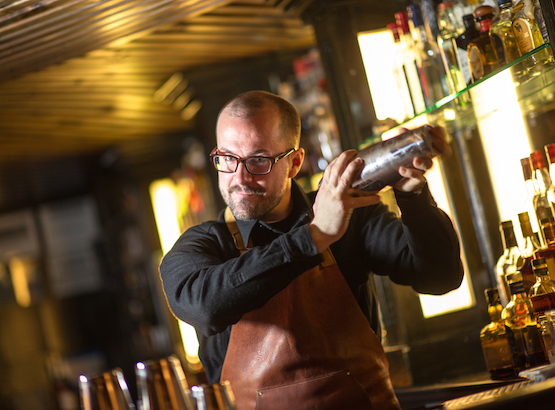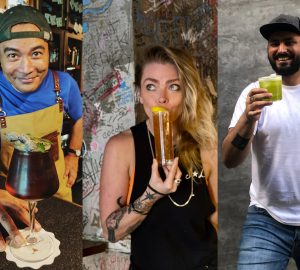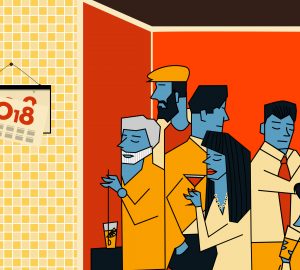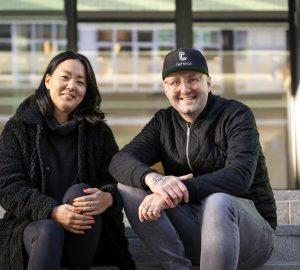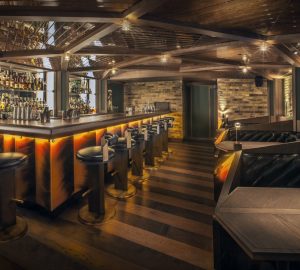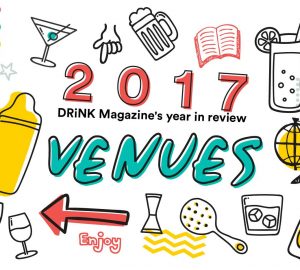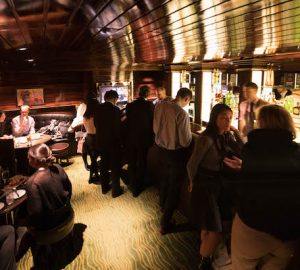Bar royalty Jim Meehan and Jeff Bell of New York icon PDT on their month-long speakeasy pop-up at Hong Kong’s Landmark Mandarin Oriental. By Andrea Lo.
Why did you host a month-long pop-up in HK when PDT elsewhere only lasted a week?
Jeff Bell: We hadn’t done anything to this extent yet in our week-long pop-ups, and couldn’t justify spending the resources to do this for only a week. This gave us an opportunity to give a better representation of our bar back home.
Jim Meehan: I was eager to do this because I worked with [Landmark Mandarin Oriental executive chef] Richard Ekkebus six years ago during the first Masters of Mixology pop-up event. Richard takes drinks seriously, which is incredibly rare among World’s 50 Best and Michelin chefs. Most chefs of his tenure and age don’t have cocktail programs in their restaurants and don’t prioritise or think of cocktails as a culinary art. Of course, I put the hot dogs in his hands, and he did not disappoint.
JB: This was also something that Martin Newell of Diageo Reserve and I dreamed up and once we decided it was going to happen, we all started talking, and it was an exhausting process. Then I had a child in the middle of it.

How faithful was the recreation?
JM: It’s pretty dead-on. I wouldn’t say that we changed anything, but I feel there were subtle differences between the real bar and the pop-up. The phone booth is our iconic entrance, which is important and transportive. There was taxidermy, which helps lend some levity to what at times can feel like a heavy concept. The back bar was the most facsimile of the original. The Hong Kong bar was more of a standing bar, while we have a longer seated bar in New York. We have a wood floor in New York, whereas we had a fine carpet in Hong Kong. PDT Hong Kong was a little bit nicer.
Would you consider setting up something more permanent here?
JM: The city really is a great fit for PDT. We would never do another pop-up in Hong Kong, but we would certainly entertain offers to open up a permanent PDT.
JB: It’s all about waiting for the right partnerships and the right timing, kind of striking when the iron is hot. I’d love to open a bar in Hong Kong, but am I going to fly out here and make it happen? No. If something organically happens, then yes.

How did you decide on the PDT Hong Kong menu?
JB: All these drinks went through the same process as those that end up on the menu in New York. It was a long process, with trial and error, tweaking and recipe development. We couldn’t come to Hong Kong beforehand to try everything, so I spent some time in New York City’s Chinatown. It’s hard to get through a grocery store that’s all in Chinese – I wish there was an interpreter to help me out.
JM: I had oolong tea that I sourced in Chicago. I brought tea to China, which is hilarious. This event really was about hyper-localisation. It’s a celebration of the relationship we all have as global citizens. A great drink is not just a shopping list of great ingredients. It’s how those ingredients are put together. If you understand the history of cocktails and know how to make the archetypal drinks – like a Daiquiri, Martini, Old Fashioned or Tom Collins – the improvisational nature of creating new drinks comes from understanding that art form. It’s very much like jazz.

Do you think New York is still the centre of the cocktail world?
JM: I think you could make a strong argument for London. I don’t see that changing. There’s also a strong scene in Sydney, although I haven’t spent enough time there to comment on what they’re doing. Some cities, like Tokyo, don’t get as much of the spotlight as they should, because they don’t play the game. In Tokyo there’s a language barrier. You also have bartenders like Kazuo Uyeda at Bar Tender – the media is not important to him and he doesn’t make time for it. Guys like Alex Kratena, Sean Muldoon and Antonio Lai – they play the game. They deserve all the attention they get, but part of it is the graciousness and the commitment to having their stories told.
JB: The bartending scene in Hong Kong seems to be very international. It’s akin to London. If you go to a bar in London, there would be English bartenders alongside Czech, Italian, French. I think you’re going to see a lot of that here in Hong Kong too.
JM: What I think Hong Kong bartenders get is that when you do this long enough, you begin to realise you’re not just in the bar or drinks business – you’re in the people and relationships business. One of the reasons why PDT became one of the most famous speakeasies in the world is because Sasha Petraske at Milk & Honey refused to do interviews. It’s that simple. Part of growing your renown has to be making communications a priority – it takes a lot of time.

Jim, you’ve done it all from co-designing beautiful leather bar accessories to helping develop a cult rum, all while operating a World’s Best Bar – in bartender dreamland terms, have you arrived?
JM: No one talks about all the things that haven’t happened or worked out – thankfully. I wake up every day and pinch myself. That being said, the second you believe your own hype, in this business, you’re done. Have I had a great run so far? Yes. But do I let it go to my head? No.
JB: I think that there is a little bit of a misconception about this industry. The bar industry is growing rapidly around the world, especially in the United States. We get to travel the world and do a lot of fun stuff. That might be a place that a bartender might want to get to at some point, but that shouldn’t be the goal. Jim does ten or 11 shifts in two weeks. He’s super happy behind the bar because he loves service, being with guests and making drinks. Somebody who wants to do that – that’s what makes you a great bartender.
PDT / 113 St Marks Place, New York / +212 614 0386


